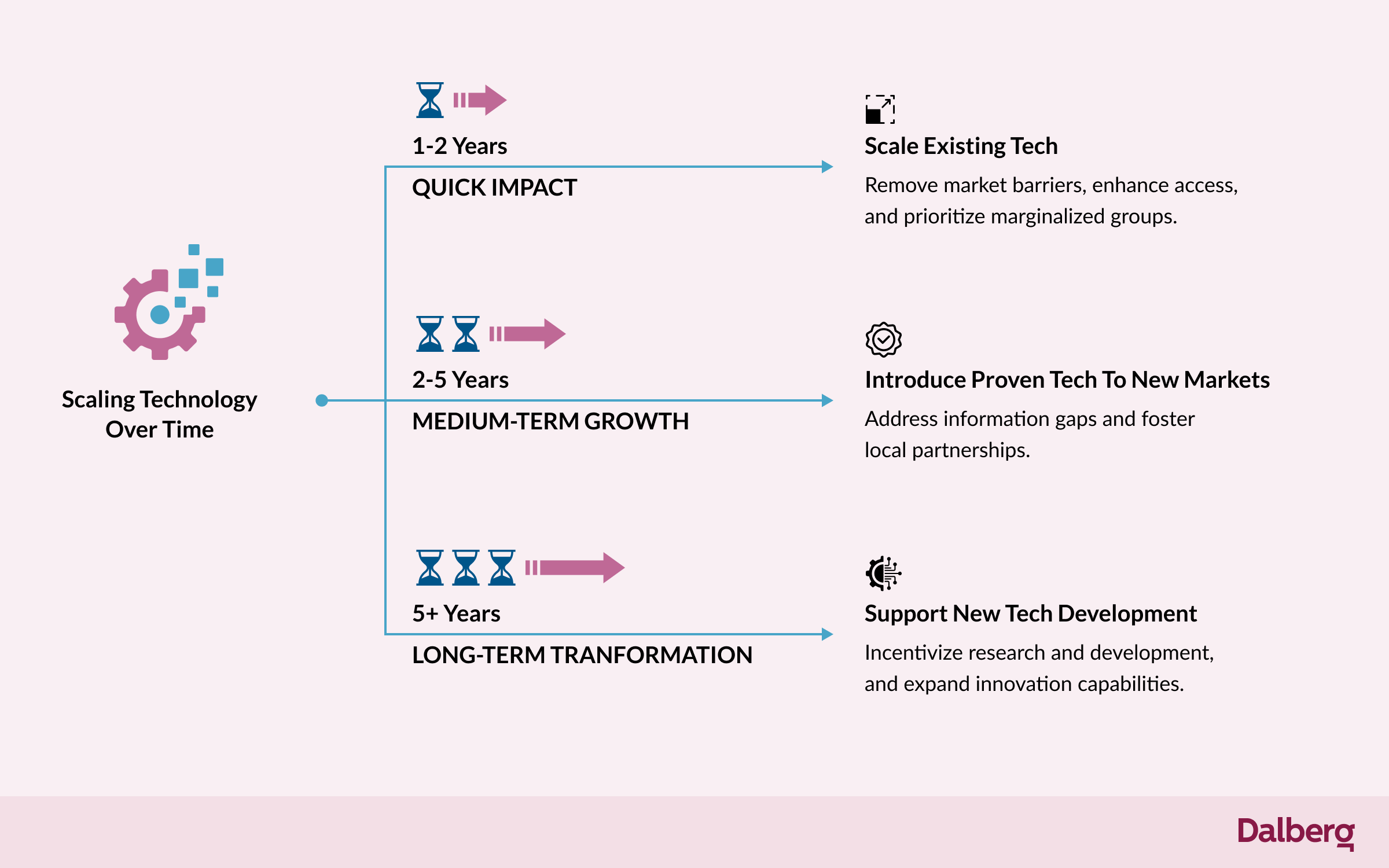Dalberg uses cookies and related technologies to improve the way the site functions. A cookie is a text file that is stored on your device. We use these text files for functionality such as to analyze our traffic or to personalize content. You can easily control how we use cookies on your device by adjusting the settings below, and you may also change those settings at any time by visiting our privacy policy page.
When serving hard-to-reach customers, it is crucial to make ‘technology for good’ work on the ground and not only in the lab—addressing real needs rather than simply following hyped-up trends. Outside of tech enterprises, a broader set of organizations such as philanthropic foundations and social-impact-focused corporations play a critical role in ensuring that tech innovation reaches the people who need them. They are uniquely placed to help innovations leapfrog traditional development hurdles. From providing AI-powered translation tools that open up multiple markets to solar-powered solutions tackling cold chain logistics challenges, technology has shown immense potential to deliver impactful, scalable solutions where they are needed most.
The journey to scale is challenging, resulting in high failure rates for innovations with tremendous impact potential. Numerous obstacles along the scale-up journey have led to failure rates as high as 95% for new products—especially those aiming to serve underserved populations.[1] Many tech companies experience the ‘valley of death’ where they struggle to move from proof-of-concept to large-scale adoption when addressing market gaps in low-resource settings. This gap is often driven by insufficient financing, fragmented markets, inconsistent support, and political instability. As the world advances in technology, the growing digital divide increasingly leaves marginalized and hard-to-reach communities even further behind. AI models, for example, often prove less effective for marginalized communities due to their reliance on unreliable local data, leading to inaccurate decisions and poor resource allocation.[2] This disconnect between tech potential and its practical deployment widens disparities in market access and slows progress toward achieving scale.
To overcome these barriers, we need better approaches to bridge the gap between innovation and practical impact, ensuring that technology designed for good reaches those who need it most.
From Dalberg’s experience working with organizations scaling technology for good, we have identified five approaches to navigate these challenges—especially for hard-to-reach communities:
- Capitalize on market shifts: Tech solutions that capitalize on market shifts see accelerated adoption by seizing emerging market gaps to fulfill previously unmet needs within marginalized communities. Technologies that successfully scale to reach underserved customers (e.g., in rural areas or lower-income households) often do so by capitalizing on significant changes in the market environment. This includes looking at legal and regulatory frameworks and wider societal norms. By closely monitoring shifts, organizations can seize moments of opportunity to scale rapidly. Regulatory changes in response to the COVID-19 pandemic illustrate such shifts. In France, during a time where health systems were strained in reaching everyone who needed it, telehealth app Doctolib took advantage of a policy reform—a shift to allowing reimbursement for virtual medical appointments—to scale to one million video consultations in March 2020 alone, compared with 150k in all of 2019. Flexibility and the capacity to adapt to changing markets was crucial in this case.[3]
- Explore fit-for-purpose innovative finance mechanisms to drive adoption and mitigate risks: Scaling technology in under-served markets often carries significant financial risk, which can deter risk-averse investors. ‘Pull mechanisms’ such as advance market commitments (AMCs)[4] or volume guarantees can help reduce investor hesitancy and increase market certainty. Originally effective in sectors like healthcare, where high upfront R&D with uncertain demand is common, AMCs are now being applied beyond health. For example, Frontier Climate, has adapted this model to drive the adoption of emerging climate technologies, creating a platform where businesses commit to buying carbon removal credits, thus supporting scaling efforts through guaranteed revenue streams.[5] By creating assured demand and reducing financial risks for investors and innovators—who might otherwise lack incentives to invest in technologies aimed at marginalized groups—pull mechanisms accelerate the deployment of transformative technologies.
- Harness ecosystems to solve problems: Building and harnessing the right ecosystem can address interconnected challenges that hinder growth, helping technologies adapt to local contexts and ensuring that supportive policies, partnerships, and infrastructure are in place for successful scaling. Scaling tech to hard-to-reach users requires the creation of an enabling environment through an ecosystem approach. An ecosystem approach supports seamless technology integration, accelerates adaptation, and expands the range of contextually relevant solutions. For example, the UCL-Ventura CPAP partnership improved the ecosystem for tech integration by addressing regulatory reform and making their technology open-source, reducing the barriers for local actors to manufacture or assemble it.[6] This ecosystem approach allowed the UCL-Ventura CPAP device to scale rapidly, delivering affordable respiratory support to marginalized communities lacking ventilators during COVID-19 and filling critical gaps in healthcare access. Similarly, Fundación Chile fostered strong connections between local and international actors to scale Latin America’s first unsubsidized solar plant by leveraging global partnerships, joint ventures with angel investors, and staged funding to secure private investments to meet growing demand in sectors like mining.
- Use alternative data-driven approaches to prioritize solving customer problems: In data-scarce environments, innovative data approaches can help organizations bridge information gaps, reduce scaling costs, and improve decision-making. Moove, a successful African mobility fintech, used proprietary performance and revenue analytics to underwrite customers. This alternative data allowed them to address the lack of access to vehicle financing for drivers in Africa and the Middle East. By using innovative data sources to assess creditworthiness, Moove was able to provide individuals with a pathway to obtaining a credit score, facilitating their access to drive-to-own (DTO) vehicle financing through the Moove platform.[7]
- Leverage existing infrastructure and trust networks: By leveraging trusted networks and simple, available technology, organizations can achieve scale more rapidly, making high-impact solutions accessible in even the most remote communities. Tech innovations that have rapidly scaled in emerging markets tend to rely on existing underlying software and customer behavior. This helps reduce the cost to scale up, improves innovation quality, and boosts user experience. By building on what is already trusted and functional, organizations can bypass the need for costly R&D or infrastructure overhauls. In Kenya and Tanzania, M-PESA successfully used widely available USSD/STK technology to deploy e-payment technology and was able to register 20% of Kenyans on the service within two years of launch.[8]
These approaches target measurable impact at scale, with strategies informed by our on-the-ground experience.
Tech-focused organizations play an important role in unlocking these enablers. However, to effectively achieve scale, they should carefully consider the following:
What is needed from funders, investors, and other key ecosystem actors to unlock these enablers?
- Technology selection and maturity alignment: The choice of technology to back should match the desired timeline for impact. Supporting mature technologies can lead to quicker adoption and measurable results while investing in emerging innovations will likely require a longer runway. Tech-focused organizations, especially those offering financing, must adjust their scaling strategies based on the technology’s maturity level and their timeline for impact (see figure below).

- Tailored impact models: Ecosystem actors need to be clear about the impact model they are aiming to support, given the diverse needs of end-users. For example, they need to be clear on whether the goal is to show the pathway for innovations that are easy for others to replicate (e.g., open-source software for good or public infrastructure) or scale up profitable services that could be widely deployed commercially (e.g., some agritech innovations). Tech-focused organizations should consider which impact model aligns best with their mission, ensuring that their interventions promote sustainable, equitable growth in underserved populations in the regions they serve.
- Coordination, not competition, for those supporting entrepreneurs: A major challenge for scaling tech enterprises is the fragmentation of support for technology innovators. In East and West Africa for example, the green-tech ecosystem is deeply fragmented and uncoordinated. Kenya alone has 74+ private incubators, accelerators, and private hubs, sometimes with overlapping ambitions.[9] While many entrepreneurs receive assistance at the seed or early startup stage, they are often left on their own at the growth phase before they attract attention from venture capital. To address this, tech-focused actors must create a more coordinated ecosystem where support is continuous and bridges the ‘missing middle.’ This means providing sector-specific expertise, patient capital, and mentorship that can help entrepreneurs navigate operational and market challenges as they move from early-stage to growth and scale.
- Embracing flexible structures: Many organizations looking to pivot into supporting technology more strongly often find they need to bring in new skill sets and ways of thinking—for example, when grappling with how to incorporate artificial intelligence into their work. One way to address this is by bringing in external expertise with fresh thinking or creating relatively independent teams dedicated to fostering innovation and scale-up—for example, the Sanitation and Hygiene Fund setting up Capital M to develop moonshot ideas on menstrual health and hygiene, or innovation labs within corporations (such as Google X operating independently to develop breakthrough technologies within Google[10]). This enables the development of more agile, forward-thinking strategies while still staying connected to the organization’s core mission.
Scaling promising technologies to those most in need is inherently a complex process requiring trial and error rooted in customer needs. By focusing on fit-for-purpose innovation, fostering collaboration, de-risking investments, and strengthening value chains, impact-focused organizations can better bridge the gap between potential and reality, ensure that technologies are supported effectively throughout their scale-up journey, and unlock impact for communities that need them the most.
———
[1] Why 95% of new products miss the mark (and how yours can avoid the same fate), MIT Professional Education
[2] For more information on how the impacts of insufficient investment in data ecosystems see: Investment Case: Multiplying Progress Through Data Ecosystems
[3] Stripe, Doctolib partners with Stripe to support an influx of 30K+ new physicians (2024); TechCrunch, Doctolib is now used by 300,000 doctors and medical workers (2022)
[4] An Advance Market Commitment (AMC) is a financial mechanism designed to incentivize the development and supply of innovative products, particularly those that are underdeveloped due to high upfront costs and uncertain demand. In an AMC, buyers (usually governments or international organizations) commit to purchasing a product at a pre-agreed price once it is successfully developed, thereby guaranteeing a market for the product.
[5] Frontier Climate, Progress, 2024; Quantifying delivered carbon removal as a buyer of early technologies, 2022; Expert Interviews
[6] The Royal Academy of Engineering and Engineering X, Global review of the engineering response to COVID-19: lessons learned for preparedness and resilience (2022); The Royal Academy of Engineering, RAENG President’s special awards for pandemic service (2022)
[7] Wamda, Moove raises $30 million from debut sukuk for UAE expansion (2022); Moove, About Moove (2024); Moove, Mobility fintech Moove raises $30 million from debut sukuk to build the largest EV ride-hailing fleet in the MENA region (2022); GSMA, What’s going on with transport tech start-up financing in Africa? (2023); BII, British International Investment launches new name in Nigeria with US $20m commitment to mobility fintech Moove (2022); Uber, Uber announces first SSA-wide vehicle access partnership with Moove (2020)
[8] World Bank, Mobile Payments go Viral: M‐PESA in Kenya, 2010.
[9] Understanding the Kenyan Startup Ecosystem
[10] Dalberg Analysis; Google X
To know more about our experience working with organizations scaling technology for good, contact:




